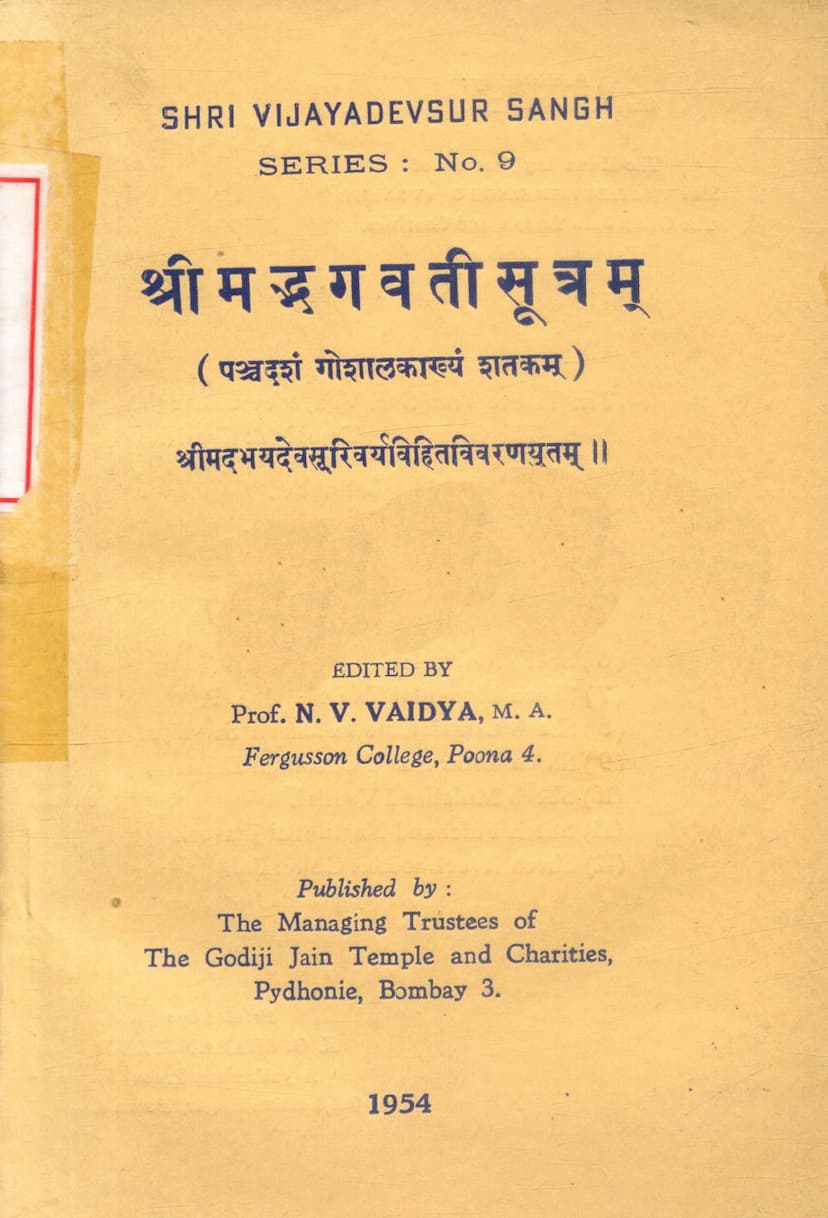Bhagwati Sutram
Added to library: September 1, 2025

Summary
This document is the preface and initial pages of the Bhagwati Sutra, specifically the Fifteenth Sataka (Chapter), titled "Goshalaka" (गोशालकाख्यं शतकम्). It was edited by Prof. N. V. Vaidya and published in 1954 by the Trustees of the Godiji Jain Temple and Charities, Bombay, as part of the Shri Vijayadevsur Sangh Series.
Here's a breakdown of the content:
1. Publication Details and Acknowledgements (Pages 1-6):
- Title: श्रीमद्भगवती सूत्रम् (पञ्चदशं गोशालकाख्यं शतकम्) - The Bhagavati Sutra (The Fifteenth Sataka called Goshalaka).
- Commentary: श्रीमदभयदेवमूरिवर्यविहितविवरणयुतम् - With the commentary of the venerable Shri Abhayadev Suri.
- Editor: Prof. N. V. Vaidya, M. A., Fergusson College, Poona.
- Publisher: The Managing Trustees of The Godiji Jain Temple and Charities, Bombay.
- Series: Shri Vijayadevsur Sangh Series, No. 9.
- Context: The preface explains that this particular Sataka was prescribed by the University of Bombay for the M.A. examination in 1954 and 1955. An earlier edition by Dr. P. L. Vaidya was out of print, causing difficulties for students.
- Financial Support: Shri Popatlal Shah, M.L.A., generously agreed to defray the entire publication costs.
- Gratitude: Prof. Vaidya expresses deep gratitude to Shri Popatlal Shah and the Trustees of the Godiji Jain Temple and Charities for their timely and generous support, calling it a significant "Dnyāna-Dāna" (gift of knowledge).
- Acknowledgement of Student Help: Prof. Vaidya also thanks his student-friend Shri P. N. Mulay, B.A., B.T., for preparing the press-copy of the commentary.
- Publisher's Note: The Vijayadevsur Sangh Gnan Samiti expresses happiness in publishing this chapter and thanks Prof. Vaidya for his guidance and contribution. They hope more students will take up the study of Ardha-Magadhi.
- List of Other Publications: A list of other books published by the same series is provided.
2. The Text of the Fifteenth Sataka (Goshalaka) (Pages 7 onwards): The core of the document begins with the Sanskrit/Prakrit text of the Bhagavati Sutra, specifically starting with the Fifteenth Sataka.
- Introduction of the Setting: The text starts by establishing the location: Savatthi (सावत्थी) city, and mentions a potter named Halahala (हालाहला) who was an Ājivika follower.
- Introduction of Makkhali Gosala: It introduces Makkhali Gosala (गोसाले मंखलिपुत्त), son of Mankhali, as a prominent Ājivika follower who lived in Savatthi.
- Gosala's Prognostications: The text describes how six "Disha-charas" (दिसायरा - literally, 'those who roam the directions', possibly referring to astrologers or soothsayers) approached Gosala. Based on an eight-part great divination, Gosala declared six inescapable pronouncements for all beings: 1. Gain (लाभ), 2. Loss (अलाभ), 3. Happiness (सुह), 4. Suffering (दुक्ख), 5. Life (जीवियं), 6. Death (मरणं).
- Gosala's Claim to Divinity: The text states that Gosala, through his divination, proclaimed himself as a Jin-like figure (जिणप्पलावी - one who speaks of Jin), an Arhat-like figure (अरहप्पलावी), an omniscient-like figure (सव्वन्नुप्पलावी), even though he was not. He was seen as someone who declared the "Jin-word" (जिणसदं) without being a Jin.
- Mahavira's Response (through Gautama): The narrative then shifts to the time when Bhagavan Mahavira (समणस्स भगवओ महावीरस्स) was present. Gautama, Mahavira's chief disciple, hears the common people discussing Gosala's claims. Gautama asks Mahavira about this, indicating his own doubt and faith (जाव जायसड्ढे). Mahavira clarifies that Gosala is not a Jin but an "A-jin" (अजिणे) who claims to be like a Jin.
- Gosala's Origin Story: Mahavira then narrates Gosala's background: his father was Mankhali. His mother was Bhadra. Gosala was born in the cow-pen (गोसाला) of a Brahmin named Gobahula (गोबहुल) in the Saravana settlement (सरवणे संनिवेसे). This is why he was named Gosala. He eventually adopted the lifestyle of his father, using a painting board (चित्तफलगं) in his hand.
- Mahavira's Interactions with Gosala and His Disciples: The subsequent verses detail interactions between Mahavira and Gosala, or Mahavira's disciples and Gosala. These passages often involve:
- Mahavira (through Gautama or other disciples) refuting Gosala's claims or exposing his limitations.
- Gosala demonstrating some powers or making pronouncements that are later challenged or explained by Mahavira.
- Discussions about Gosala's past lives and future destinies, including his eventual death and rebirths in various realms.
- Key events include:
- Gosala's followers claiming he is a Jin.
- Mahavira refuting this, explaining Gosala's true nature.
- An incident involving a sesame plant (तिलथंभए) where Gosala's prediction about its eventual yielding of sesame seeds is confirmed by Mahavira, but Gosala's disbelief is highlighted.
- An encounter with a tapasvin (ascetic) named Vaishayana (वेसियायण) where Gosala attempts to provoke him, leading to a display of heat-generating karma (तेयलेस्सं - tejalessya). Mahavira intervenes to protect Gosala and explains the nature of tejalessya and Gosala's karma.
- Gosala's eventual death in an emaciated state due to his own practices and the consequences of his actions and beliefs.
- The text elaborates on the long karmic cycle Gosala will undergo, including numerous rebirths in hellish realms, animal forms, and eventually in heavenly realms, before finally attaining liberation after a very long period.
- The narrative also touches upon other disciples of Mahavira, such as Anand and Sunakkhatra, and their interactions or observations concerning Gosala.
- The text seems to aim at establishing the truth of Mahavira's teachings and refuting the doctrines and claims of Gosala, who is portrayed as a flawed or misguided ascetic.
In essence, the Fifteenth Sataka of the Bhagavati Sutra, as presented in this edition, focuses on:
- Makkhali Gosala's life and teachings: His origins, his claims of divinity, and his prognostications.
- The refutation of Gosala's claims by Mahavira: Through detailed explanations and demonstrations of karma and destiny.
- The karmic consequences of Gosala's actions: The extensive cycle of births and deaths he will endure.
- The superiority of Mahavira's path: Emphasizing the doctrines of right faith, right conduct, and right knowledge as the means to liberation.
The edition is a scholarly effort to make this important Jain text accessible to students, providing the original text with a classical commentary.